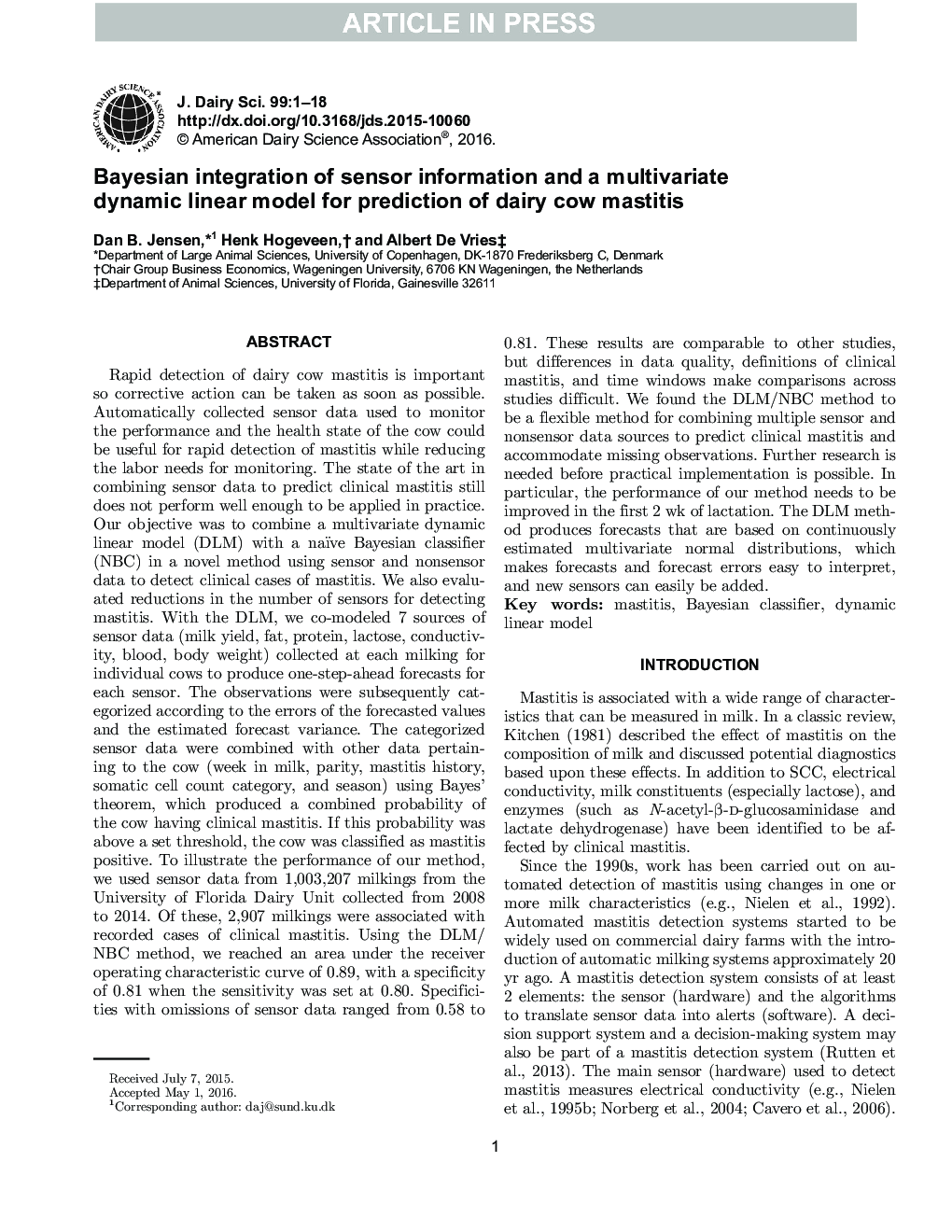| کد مقاله | کد نشریه | سال انتشار | مقاله انگلیسی | نسخه تمام متن |
|---|---|---|---|---|
| 5542843 | 1402523 | 2016 | 18 صفحه PDF | دانلود رایگان |
عنوان انگلیسی مقاله ISI
Bayesian integration of sensor information and a multivariate dynamic linear model for prediction of dairy cow mastitis
ترجمه فارسی عنوان
یکپارچه سازی بیسیم اطلاعات حسگر و یک مدل خطی پویا چند متغیره برای پیش بینی ماستیت گاو شیری
دانلود مقاله + سفارش ترجمه
دانلود مقاله ISI انگلیسی
رایگان برای ایرانیان
کلمات کلیدی
ماستیت، طبقه بندی بیزی، مدل خطی پویا
موضوعات مرتبط
علوم زیستی و بیوفناوری
علوم کشاورزی و بیولوژیک
علوم دامی و جانورشناسی
چکیده انگلیسی
Rapid detection of dairy cow mastitis is important so corrective action can be taken as soon as possible. Automatically collected sensor data used to monitor the performance and the health state of the cow could be useful for rapid detection of mastitis while reducing the labor needs for monitoring. The state of the art in combining sensor data to predict clinical mastitis still does not perform well enough to be applied in practice. Our objective was to combine a multivariate dynamic linear model (DLM) with a naïve Bayesian classifier (NBC) in a novel method using sensor and nonsensor data to detect clinical cases of mastitis. We also evaluated reductions in the number of sensors for detecting mastitis. With the DLM, we co-modeled 7 sources of sensor data (milk yield, fat, protein, lactose, conductivity, blood, body weight) collected at each milking for individual cows to produce one-step-ahead forecasts for each sensor. The observations were subsequently categorized according to the errors of the forecasted values and the estimated forecast variance. The categorized sensor data were combined with other data pertaining to the cow (week in milk, parity, mastitis history, somatic cell count category, and season) using Bayes' theorem, which produced a combined probability of the cow having clinical mastitis. If this probability was above a set threshold, the cow was classified as mastitis positive. To illustrate the performance of our method, we used sensor data from 1,003,207 milkings from the University of Florida Dairy Unit collected from 2008 to 2014. Of these, 2,907 milkings were associated with recorded cases of clinical mastitis. Using the DLM/NBC method, we reached an area under the receiver operating characteristic curve of 0.89, with a specificity of 0.81 when the sensitivity was set at 0.80. Specificities with omissions of sensor data ranged from 0.58 to 0.81. These results are comparable to other studies, but differences in data quality, definitions of clinical mastitis, and time windows make comparisons across studies difficult. We found the DLM/NBC method to be a flexible method for combining multiple sensor and nonsensor data sources to predict clinical mastitis and accommodate missing observations. Further research is needed before practical implementation is possible. In particular, the performance of our method needs to be improved in the first 2 wk of lactation. The DLM method produces forecasts that are based on continuously estimated multivariate normal distributions, which makes forecasts and forecast errors easy to interpret, and new sensors can easily be added.
ناشر
Database: Elsevier - ScienceDirect (ساینس دایرکت)
Journal: Journal of Dairy Science - Volume 99, Issue 9, September 2016, Pages 7344-7361
Journal: Journal of Dairy Science - Volume 99, Issue 9, September 2016, Pages 7344-7361
نویسندگان
Dan B. Jensen, Henk Hogeveen, Albert De Vries,
